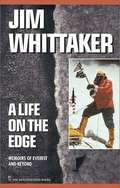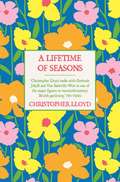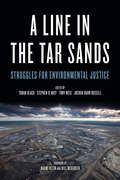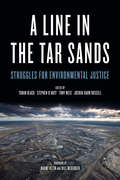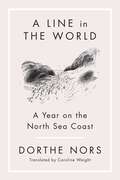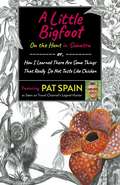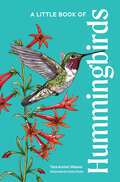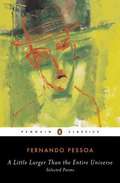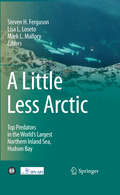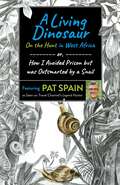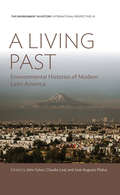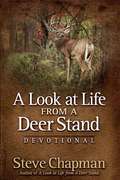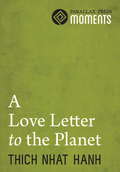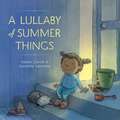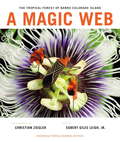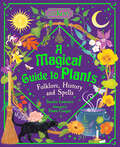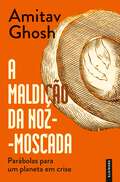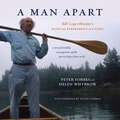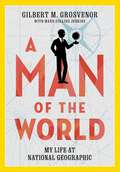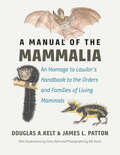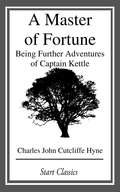- Table View
- List View
A Life on the Edge: Memoirs of Everest and Beyond
by Jim WhittakerJim Whittaker's achievement on Everest and his many successes before and after are the natural outcome of a life driven by a passion for outdoor adventure combined with strong leadership qualities and a commitment to making a difference. In A Life on the Edge, readers will discover a true hero-someone who tells his story not to boast or preach, but to share his love of the environment and outdoor adventure and to inspire others to seek challenges in their own lives.
A Lifetime of Seasons: The Best of Christopher Lloyd
by Christopher Lloyd'He was the best informed, liveliest and most innovative gardening writer of our times' GUARDIAN'Infuriating, irascible ... a brilliant gardener and a brilliant writer' Monty Don, ObserverChristo Lloyd was recognised as one of the foremost gardeners and garden writers of the 20th century. Here, for the first time, is the definitive collection of his best, most informative, and so often amusing, garden writing.Christo on gardening: Ours, in its humble way, is an art as well as a craft. At the same time it keeps us in touch with the earth, the seasons, and with that complex of interrelated forces both animate and inanimate which we call nature. It is a humanizing occupation.On weeding:Many gardeners will agree that hand-weeding is not the terrible drudgery that it is often made out to be. Some people find in it a kind of soothing monotony. It leaves their minds free to develop the plot for their next novel or to perfect the brilliant repartee with which they should have encountered a relative's latest example of unreasonableness.
A Line Above the Sky: On Mountains and Motherhood
by Helen MortGuardian Books to Watch 2022Evening Standard Books to Watch 2022Bookseller Editor's ChoiceWinner of the Boardman Tasker Award for Mountain Literature'A wonderful book - exhilarating and taut, fearless in its explorations of wildness, risk, motherhood, and the inner and outer worlds of the writer' Jon McGregor'This book is beautiful' Emma Jane Unsworth'Climbing gives you the illusion of being in control, just for a while, the tantalising sense of being able to stay one move ahead of death'As a child, Helen Mort was drawn to the thrill and risk of climbing, the tension between human and rockface, and the climber's need to be hyperaware of the sensory world - to feel the texture of rock under their fingers, how their crampons bite into the ice, the subtle shifts in weather. But when she becomes a mother for the first time, she finds herself re-examining this most elemental of disciplines, and the way that we view women who put themselves in danger.Written by one of Britain's most talented young writers, A Line Above the Sky melds memoir and nature writing to create what will surely become a classic of the genre; it asks why humans are compelled to climb and poses other, deeper questions about self, motherhood and freedom. It is a love letter to losing oneself in physicality, whether that in the risk of climbing a granite wall solo, without ropes, or the intensity of bringing a child into the world.
A Line in the Tar Sands: Struggles for Environmental Justice
by Black, Toban; D'Arcy, Stephen; Weis, Tony; Kahn Russell, Joshua; Klein, Naomi; McKibben, BillTar sands “development” comes with an enormous environmental and human cost. But tar sands opponents—fighting a powerful international industry—are likened to terrorists; government environmental scientists are muzzled; and public hearings are concealed and rushed. Yet, despite the formidable political and economic power behind the tar sands, many opponents are actively building international networks of resistance, challenging pipeline plans while resisting threats to Indigenous sovereignty and democratic participation. Featuring contributions from Winona LaDuke, Bill McKibben, Naomi Klein, Clayton Thomas-Muller, Harsha Walia, Jeremy Brecher, Crystal Lameman, Melina Laboucan-Massimo, Yves Engler, Cherri Foytlin, Macdonald Stainsby, Yudith Nieto, Greg Albo, Brian Tokar, Jesse Cardinal, Rex Weyler, Jess Worth, and many more. The editors’ proceeds from this book will be donated to frontline grassroots environmental justice groups and campaigns.
A Line in the Tar Sands: Struggles for Environmental Justice
by Joshua KahnThe fight over the tar sands in North America is among the epic environmental and social justice battles of our time, and one of the first that has managed to marry quite explicitly concern for frontline communities and immediate local hazards with fear for the future of the entire planet. Tar sands "development" comes with an enormous environmental and human cost. But tar sands opponents—fighting a powerful international industry—are likened to terrorists; government environmental scientists are muzzled; and public hearings are concealed and rushed. Yet, despite the formidable political and economic power behind the tar sands, many opponents are actively building international networks of resistance, challenging pipeline plans while resisting threats to Indigenous sovereignty and democratic participation. Including leading voices involved in the struggle against the tar sands, A Line in the Tar Sands offers a critical analysis of the impact of the tar sands and the challenges opponents face in their efforts to organize effective resistance. Contributors include Angela Carter, Bill McKibben, Brian Tokar, Christine Leclerc, Clayton Thomas-Muller, Crystal Lameman, Dave Vasey, Emily Coats, Eriel Deranger, Greg Albo, Jeremy Brecher, Jess Worth, Jesse Cardinal, Joshua Kahn Russell, Lilian Yap, Linda Capato, Macdonald Stainsby, Martin Lukacs, Matt Leonard, Melina Laboucan-Massimo, Naomi Klein, Rae Breaux, Randolph Haluza-DeLay, Rex Weyler, Ryan Katz-Rosene, Sâkihitowin Awâsis, Sonia Grant, Stephen D'Arcy, Toban Black, Tony Weis, Tyler McCreary, Winona LaDuke, and Yves Engler.
A Line in the World: A Year on the North Sea Coast
by Dorthe NorsA celebrated Danish writer explores the unsung histories and geographies of her beloved slice of the world. Me, my notebook and my love of the wild and desolate. I wanted to do the opposite of what was expected of me. It’s a recurring pattern in my life. An instinct. Dorthe Nors’s first nonfiction book chronicles a year she spent traveling along the North Sea coast—from Skagen at the northern tip of Denmark to the Frisian Islands in the Wadden Sea. In fourteen expansive essays, Nors traces the history, geography, and culture of the places she visits while reflecting on her childhood and her family and ancestors’ ties to the region as well as her decision to move there from Copenhagen. She writes about the ritual burning of witch effigies on Midsummer’s Eve; the environmental activist who opposed a chemical factory in the 1950s; the quiet fishing villages that surfers transformed into an area known as Cold Hawaii starting in the 1970s. She connects wind turbines to Viking ships, thirteenth-century church frescoes to her mother’s unrealized dreams. She describes strong waves, sand drifts, storm surges, shipwrecks, and other instances of nature asserting its power over human attempts to ignore or control it. Through a deep, personal engagement with this singular landscape, A Line in the World accesses the universal. Its ultimate subjects are civilization, belonging, and change: changes within one person’s life, changes occurring in various communities today, and change as the only constant of life on Earth.
A Little Bigfoot: or, How I Learned There Are Some Things That Really Do Not Taste Like Chicken
by Pat SpainIn the course of Pat Spain's time filming wildlife-adventure TV series, he's gotten pretty used to being uncomfortable. There've been rabid raccoon attacks, days spent in the baking equatorial African sun, and consumption of many revolting local delicacies like fermented mare's milk. And then there was Sumatra. On the Hunt in Sumatra details the two weeks Pat spent soaking wet with a National Geographic film crew tracking the legendary Orang Pendak through the forests of Indonesia, while tigers, leeches, amorous orangutans, Coldplay fans, a guide named Uncle Happy, two shaman, car demons, and rogue cameramen tracked them. It is, without a doubt, the most inhospitable terrain Pat's ever encountered, with the highest likelihood of grievous bodily harm. But the payoff is the theory he reached about Orang Pendak, and a 5 a.m. EDM Tai Chi party.
A Little Book of Hummingbirds
by Tara Austen WeaverThis bestselling journey into the world of the hummingbird is a treasure and a gift for birdwatchers, gardeners, and anyone who loves these amazing little creatures. Lavishly illustrated with 45+ original ink-and-watercolor illustrations of the species most commonly found in the US and Canada.Hummingbirds are beautiful and mesmerizing. Did you know they can flick their tongue twelve times a second? Or that they &“tile&” their nests with pieces of lichen and moss (the nests themselves are spun from spiderwebs and thistledown)? Or that some species sing and dance as they woo their mates? Perhaps it&’s no surprise that hummingbirds elicit such enthusiasm from those who love them. This small-format hardcover book includes:45 lifelike ink-and-watercolor drawings showcasing all the species commonly found in the US and Canada, as well as the most frequent visitors—often depicted with their favorite flowers. Includes all males and many females.Fascinating facts on cultural history, folklore, migration patterns, habitat, lifecycle, biology, and anatomyInformation on creating your own hummingbird haven using feeders, flowers, water, and shelterBirdwatching tips and best places to visit to see hummingbirdsThis book is part of the collectible mini book series Little Book of Natural Wonders, and makes a gorgeous gift (or irresistible treat for yourself) for all hummingbird lovers!
A Little Larger Than the Entire Universe: Selected Poems
by Fernando PessoaThe largest and richest English-language volume of poetry from &“the greatest twentieth-century writer you have never heard of&” (Los Angeles Times) Edited, Translated, and with an Introduction by Richard Zenith, the author of the Pulitzer Prize finalist Pessoa: A BiographyA Penguin Classic Writing obsessively in French, English, and Portuguese, poet Fernando Pessoa (1888–1935) left a prodigious body of work, much of it credited to three &“heteronyms&”―Alberto Caeiro, Ricardo Reis, and Alvaro de Campos―alter egos with startlingly different styles, points of view, and biographies. Offering a unique sampling of his most famous voices, this collection features Pessoa&’s major, best-known works and several stunning poems that have come to light only in this century, including his long, highly autobiographical swan song. Featuring a rich body of work that has never before been translated into English, this is the finest introduction available to the stunning breadth of Pessoa&’s genius.
A Little Less Arctic: Top Predators in the World's Largest Northern Inland Sea, Hudson Bay
by Lisa L. Loseto Ferguson Steven H Mark L. MalloryIn Arctic Canada, Hudson Bay is a site of great exploration history, aboriginal culture, and a vast marine wilderness supporting large populations of marine mammals and birds. These include some of the most iconic Arctic animals like beluga, narwhal, bowhead whales, and polar bears. Due to the challenges of conducting field research in this region, some of the mysteries of where these animals move, and how they are able to survive in such seemingly inhospitable, ice-choked habitats are just now being unlocked. For example, are polar bears being replaced by killer whales? This new information could not be more salient, as the Hudson Bay Region is undergoing rapid environmental change due to global warming, as well as increased pressures from industrial development interests. A Little Less Arctic brings together some of the world's leading Arctic scientists to present the current state of knowledge on the physical and biological characteristics of Hudson Bay.
A Living Dinosaur: or, How I Avoided Prison but was Outsmarted by a Snail
by Pat SpainOn the Hunt in West Africa finds Bostonian Pat Spain, an inexperienced but enthusiastic traveler and wildlife biologist, on the first shoot of his new National Geographic TV series in Cameroon, the Congo, and the Central African Republic. He was told it would be his &“trial by fire&” for the world of wildlife TV, and soon finds that to be literally true after their decrepit pick-up truck catches fire while doing 100 MPH on a dirt road. Things only get more uncomfortable for Pat from there as he experiences the wildlife (getting charged by a silverback gorilla and having a killer bee land on his exposed penis), the food (eating rat and face-meltingly hot peppers), and some local traditions (he's almost arrested, accidentally married, and inadvertently invites an evil forest spirit to live in the Pygmy village he's staying in), and somehow manages (in his mind, at least) to solve the mystery of Mokele M'Bembe - a supposed living dinosaur in the riverways connecting these three countries.
A Living Past: Environmental Histories of Modern Latin America (Environment in History: International Perspectives #13)
by José Augusto Pádua John Soluri, Claudia LealThough still a relatively young field, the study of Latin American environmental history is blossoming, as the contributions to this definitive volume demonstrate. Bringing together thirteen leading experts on the region, A Living Past synthesizes a wide range of scholarship to offer new perspectives on environmental change in Latin America and the Spanish Caribbean since the nineteenth century. Each chapter provides insightful, up-to-date syntheses of current scholarship on critical countries and ecosystems (including Brazil, Mexico, the Caribbean, the tropical Andes, and tropical forests) and such cross-cutting themes as agriculture, conservation, mining, ranching, science, and urbanization. Together, these studies provide valuable historical contexts for making sense of contemporary environmental challenges facing the region.
A Llama Is Not an Alpaca: And Other Mistaken Animal Identities
by Karen JamesonCombining scientific facts with the art of poetry, this is a humorous and educational picture book about animals that look alike. How do you tell a llama from an alpaca, an alligator from a crocodile, or a dolphin from a porpoise? The animal kingdom is full of creatures that look so similar to others that they are often confused for each other. A Llama Is Not an Alpaca pairs rhyming animal riddles with factual responses to both teach and engage young readers as they compare and contrast features of commonly misidentified animals. How many will you get right?!
A Log's Life
by Wendy PfefferOne stormy day a strong wind rages through the forest, causing an old oak tree to bend and sway. Lightning strikes; the tree crashes to the ground. Now it's a giant log.
A Look At Life From A Deer Stand Devotional
by Steve ChapmanSteve Chapman, avid hunter and bestselling author of A Look at Life from a Deer Stand (more than 300,000 copies sold), has a gift for gleaning faith lessons from the glories of creation. This pocket-sized gathering of devotions, handsomely bound in a soft, suede-like cover, invites readers to join in the thrill of the pursuit, the celebration of nature, and the enjoyment of God's presence. Each devotion begins with the inspiration of a Scripture verse and closes with the stillness of a prayer. Readers will be excited by the application of biblical wisdom, delighted by the humor, caught up in the adventure of hunting, and intrigued by the exploration of God's character. An ideal gift for Steve Chapman fans, hunters, outdoor enthusiasts, and anyone who wants to take aim at spiritual growth.
A Love Affair with Birds: The Life of Thomas Sadler Roberts
by Sue LeafThe father of Minnesota ornithology, whose life story opens a window on a lost world of nature and conservation in the state&’s early days Imagine a Minneapolis so small that, on calm days, the roar of St. Anthony Falls could be heard in town, a time when passenger pigeons roosted in neighborhood oak trees. Now picture a dapper professor conducting his ornithology class (the university&’s first) by streetcar to Lake Harriet for a morning of bird-watching. The students were mostly young women—in sunhats, sailor tops, and long skirts, with binoculars strung around their necks. The professor was Thomas Sadler Roberts (1858–1946), a doctor for three decades, a bird lover virtually from birth, the father of Minnesota ornithology, and the man who, perhaps more than any other, promoted the study of the state&’s natural history. A Love Affair with Birds is the first full biography of this key figure in Minnesota&’s past.Roberts came to Minnesota as a boy and began keeping detailed accounts of Minneapolis&’s birds. These journals, which became the basis for his landmark work The Birds of Minnesota, also inform this book, affording a view of the state&’s rich avian life in its early days—and of a young man whose passion for birds and practice of medicine in a young Minneapolis eventually dovetailed in his launching of the beloved Bell Museum of Natural History.Bird enthusiast, doctor, author, curator, educator, conservationist: every chapter in Roberts&’s life is also a chapter in the state&’s history, and in his story acclaimed author Sue Leaf—an avid bird enthusiast and nature lover herself—captures a true Minnesota character and his time.
A Love Letter To The Planet
by Thich Nhat HanhA passionate appeal for ecological mindfulness and strengthening our relationship to the Earth. Based on the best selling The World We Have.
A Lullaby of Summer Things
by Natalie ZiarnikIn the spirit of such bedtime favorites as Emily Winfield Martin's Day Dreamers, here is a quintessential end-of-day by the beach lovingly captured and perfect for reading aloud. This simple, lyrical picture book is as warm, reassuring, and filled with joy as a vacation at the beach. <p><p>Readers will join a little girl and her siblings as they wind down from a perfect day—hanging up towels, eating dinner, and getting ready for bed—each activity sparking a memory of their day—playing catch with the dog, chasing waves, and looking at sailboats along the shore. And when the lights of the family beach house go off—"In the dusky evening light, a sleepy house says goodnight"—young listeners will be lulled to sleep themselves.
A Magic Web
by Christian Ziegler Egbert Giles LeighThe tropical forest of Panama's Barro Colorado Island is a luxuriant community of plants and animals, pulsating with life and offering an astonishing view of nature's myriad processes. What does the forest look like? How do the activities of the forest's plants and animals create a community?In A Magic Web, photographer Christian Ziegler and evolutionary biologist Egbert Giles Leigh, Jr., invite readers to enter the marvelous world of Barro Colorado Island. This book is a unique combination of spectacular photography and clear, authoritative text written by an active scientist who has spent half a lifetime trying to understand the tropical forest. Luscious photographs of the forest reveal the wonderful diversity of its inhabitants and show many of the activities that give it its character and lend structure to its community. Drawing on decades of work on Barro Colorado Island, Egbert Leigh explains how the forest works: how plants and animals compete with but also depend on each other; how the solitary lives of cats contrast with the intricately organized lives of armies of ants; the variety of ways plants struggle for a place in the sun; and how these plants attract animals to pollenate their flowers. Finally, the book shows the importance of tropical forests to the people living near them, why they matter to the world at large, what we can learn from them, and how they differ from temperate-zone forests.Full of stunning full-color photographs accompanied by clear and accessible text, A Magic Web is a must for anyone planning to visit a tropical forest and for all those who wish they could.
A Magical Guide to Plants: Folklore, History and Spells
by Sandra LawrenceMadame Volare, apothecarist and witch extraordinaire invites you to be her apprentice and learn about the world's most magical plants.For thousands of years, plants have been used to heal and soothe. Discover the amazing power within a humble leaf, seed, petal and stem, and how our ancestors feared or revered flowers and herbs. From the mandrake that bestows luck to the calming St John's wort, take a fascinating walk through a witch's garden, exploring the uses, folklore and history of over fifty common plants.Respect and marvel at the pure magic of the natural world and how you can harness its power for your own health and happiness.
A Maldição da Noz-Moscada: Parábolas para um Planeta em Crise
by AMITAV GHOSHUm livro polémico, uma crítica à cosmovisão do Ocidente por um dos mais conceituados romancistas da atualidade. Decorria o ano de 1621. A simples queda de um objeto, uma candeia, é o pretexto para o comandante das tropas holandesas aquarteladas numa das ilhas Banda, no território das Molucas, dar início ao massacre de toda a população local. Poucos habitantes sobreviveriam, e a sua língua e cultura perder-se-iam para sempre. A eliminação do povo Banda é um dos grandes genocídios esquecidos pela História. O motivo: o controlo por parte da Venerável Companhia das Índias Orientais do rentável comércio milenar da noz-moscada, uma especiaria muito apreciada na Europa pelos seus usos culinários e medicinais, de preço exorbitante, e cuja inteira produção mundial estava circunscrita até então a esse pequeno arquipélago do Índico. Em pleno século XXI, Amitav Ghosh, com mão de romancista, traz à luz este episódio negro, que serve de ponto de partida para relacionar o passado com o presente, o colonialismo com a atual crise climática, e explicar o mundo em que vivemos: da crise dos refugiados ao movimento Black Lives Matter, às cidades modernas ou mesmo às naturezas-mortas do período áureo da pintura holandesa. «Não deixem de ler este livro.» Naomi Klein «Urgente, maravilhoso e ambicioso… um livro de leitura obrigatória.» Times Literary Supplement «Ghosh recorre à literatura de viagens, à narrativa pessoal, à análise histórica e àsíntese de um vasto conhecimento académico para contar a história do nosso império ocidental e do extermínio do nosso mundo.» Los Angeles Review of Books «A Maldição da Noz-Moscada é, ao mesmo tempo, uma biografia não autorizada desta especiaria e um apelo a novas políticas que respeitem a ação ou “vitalidade” dos seres não humanos que nos rodeiam.»The White Review «Esclarecedor... Ghosh faz-nos pensar nas estruturas globais de poder que envolvem a subjugação física de povos e de territórios e, sobretudo, na ideia de conquista como um processo de extração.» The New Yorker«Um feito notável e um título atual, A Maldição da Noz-Moscada recorda-nos a razão pela qual a terra está a chorar.» Booklist «Ghosh escreveu uma obra que atinge o nosso cérebro e o nosso coração com uma clareza moral e analítica inesquecível.» Bloomberg
A Man Apart: Bill Coperthwaite's Radical Experiment in Living
by Peter Forbes Helen WhybrowA story of friendship, encouragement, and the quest to design a better worldA Man Apart is the story—part family memoir and part biography—of Peter Forbes and Helen Whybrow&’s longtime friendship with Bill Coperthwaite (A Handmade Life), whose unusual life and fierce ideals helped them examine and understand their own.Coperthwaite inspired many by living close to nature and in opposition to contemporary society, and was often compared to Henry David Thoreau. Much like Helen and Scott Nearing, who were his friends and mentors, Coperthwaite led a 55-year-long &“experiment in living&” on a remote stretch of Maine coast. There he created a homestead of wooden, multistoried yurts, a form of architecture for which he was known around the world.Coperthwaite also embodied a philosophy that he called &“democratic living,&” which was about empowering all people to have agency over their lives in order to create a better community. The central question of Coperthwaite&’s life was, &“How can I live according to what I believe?&”In this intimate and honest account—framed by Coperthwaite&’s sudden death and brought alive through the month-long adventure of building with him what would turn out to be his last yurt—Forbes and Whybrow explore the timeless lessons of Coperthwaite&’s experiment in intentional living and self-reliance. They also reveal an important story about the power and complexities of mentorship: the opening of one&’s life to someone else to learn together, and carrying on in that person&’s physical absence.While mourning Coperthwaite&’s death and coming to understand the real meaning of his life and how it endures through their own, Forbes and Whybrow craft a story that reveals why it&’s important to seek direct experience, to be drawn to beauty and simplicity, to create rather than critique, and to encourage others.
A Man of the World: My Life at National Geographic
by Gilbert M GrosvenorThe captivating inside story of the man who helmed National Geographic over the course of six decades is a front-row seat to iconic feats of exploration, from the successful hunt for the Titanic to Jane Goodall's field studies, offering a rare portrait of one of the most iconic media empires in history and making an impassioned argument for our enduring need to know and care for our world.Though his career path had been paved by four generations of his family before him, Gilbert M. Grosvenor left his own mark on the National Geographic Society, founded in 1888 and recognised the world over by its ubiquitous yellow border. In an unflinchingly honest memoir as big as the world and all that is in it, Grosvenor shows us what it was like to "grow up Geographic" in a family home where explorers like Robert Peary, Louis Leakey, and Jane Goodall regularly crossed the threshold. As staff photographer, editor in chief and then president of the organisation, Grosvenor oversaw the diversification into television, film, books, as well as its flagship magazine, which under his tenure reached a peak circulation of nearly 11 million. He also narrates the shift from a nonprofit, family-focused enterprise to the more corporate, bottom-line focused world of publishing today.For Grosvenor, running National Geographic wasn&’t just a job. It was a legacy, motivated by a passion not just to leave the world a better place, but to motivate others to do so, too. Filled with world travel, charismatic explorers, and the complexities of running a publishing empire, A MAN OF THE WORLD is the story of one man, a singular family business, and the changing face of American media.
A Manual of the Mammalia: An Homage to Lawlor’s “Handbook to the Orders and Families of Living Mammals”
by Douglas A. Kelt James L. PattonThe taxonomy of recent mammals has lately undergone tremendous revision, but it has been decades since the last update to Timothy E. Lawlor’s acclaimed identification guide the Handbook to the Orders and Families of Living Mammals. Integrating the latest advances in research, Douglas A. Kelt and James L. Patton provide this long-overdue update in their new, wholly original work, A Manual of the Mammalia. Complemented by global range maps, high-resolution photographs of skulls and mandibles by Bill Stone, and the outstanding artwork of Fiona Reid, this book provides an overview of biological attributes of each higher taxon while highlighting key and diagnostic characters needed to identify skulls and skins of all recent mammalian orders and most families. Kelt and Patton also place taxa in their currently understood supra-familial clades, and discuss current challenges in higher mammal taxonomy. Including a comprehensive review of mammalian anatomy to provide a foundation for understanding all characters employed throughout, A Manual of the Mammalia is both a user-friendly handbook for students learning to identify higher mammal taxa and a uniquely comprehensive, up-to-date reference for mammalogists and mammal-lovers from across the globe.
A Master of Fortune: Being Further Adventures of Captain Kettle
by Charles John HyneNobody who has followed the gallant sailor--diminutive, but oh, my!--in his previous adventures around the earth, is going to miss this red-hot volume of marvelous exploits.
